On-Demand Outsourcing BPO Services for Healthcare Providers With 24/7 Coverage!
Save up to 70% on staffing costs!
Browse Specialty Staffing ServicesMedical Billing Process

Author: Akansha Kumari
“Do not code it or bill for if it’s not documented in the medical record” key takeaway from professional billers. In Healthcare Revenue Cycle Medical Biller and Medical Coders is the backbone in which coders pilled billing information and billers use those codes to create insurance claims and bills for patients. We will look at how medical billing procedure connects to the existence of Medical platforms. Adoption of Varieties of Billing Systems, Methods of Hospital Reimbursement and How System works in a planned fashion along with Software supporting billing system and also its Pros and Cons.
This also enhances your knowledge about the necessary growth of this sector as we can’t allow more errors in it. According to Reports, it has been estimated that approximately 61% of initial medical claim denials are due to submitting a medical bill with incorrect information of patients.
DEFINITION: Medical billing process defines a process where claiming is done through health insurance companies by the patient with the help of a healthcare provider. Initially, the data of patient is entered in sheet and accordingly it is charged for the treatment. The medical biller follows that the claim reached to Payer, where the information is thoroughly Checked given by the patient and claims Reimbursement for the work done (Medical Facility) by the provider.
Insurance pay to the provider as per guidelines: These 3 P’s play a key role in the billing process.
PROVIDER: DOCTOR, HOSPITAL, NURSING FACILITIES
PATIENT: Person who is claiming
PAYER: INSURANCE COMPANY
3 different Medical billing systems are:
Systems which works in a collaborative manner with interlinking healthcare networks.
- CLOSED Billing System: It inhibits the transfers for medical healthcare from one platform to another and allows only single practice via using EMR (Electronic medical records).
- OPEN Billing System: It allows transfers to different healthcare organization/practitioners.
Here it uses EHR (electronic health record) which enables to communicate and collaborate efficiently.
- ISOLATED Billing System: It is completely removed from the healthcare Systems. PHR (Personal Health Records) are used in this billing system. Patients holds all their personal Information and are not transferred to any other medical systems.
What are the Methods of Hospital Reimbursement?
- Discount from Billed Charges: This lowers the risk of the producer from the payer agreeing to reimburse at a negotiated discount using the provider’s standard Charge Description Master (CDM).
- Fee-for-Service: It’s a way of paying for physician services, worldwide. The Physician is paid a separate fee for each service provided.
- Value-Based Reimbursement: Providers are compensated under a fee-for-service model with a quality and efficiency component, there are additional incentives to help create positive outcomes.
- Bundled Payments: The allowable acute and post-acute expenditures for an episode of care are predetermined.
- Shared Savings: It is a program that accelerated health care providers to come together as an Accountable Care Organization (ACO) to give high quality care to their Medicare beneficiaries.
Why do you Require Medical Billing Procedure?
To ensure the efficiency of the medical procedure and payment handling technique. Patient records are admitted correctly. Overall it plays mediator between the provider and payer. Nowadays it is handled through Digital Technology.
SKILLS REQUIREMENT FOR THE BILLING PROCESS
Medical Billers to get specialists in their work we do have a Medical Billing course where they Master their skills. Objectives of billing process are:-
à Interpret Medical Records & find code-able data
à Procedure codes for reimbursement
à Correctly capturing records of patients for faster-claiming procedure
à Gain knowledge of various reimbursement methodologies
à Linking codes to ensure claims Submission
Effective communicator: Medical billers need to have Good Oratory Skills in handling situations and conveying patients for a fast payment process.
Technical Skills: They must have knowledge of using ELECTRONIC HEALTH RECORDS used in the billing process. Aware of Database Management Software and of course typing efficiently.
Problem-Solving Skills: Along with Good Oratory skills they must handle the tough situation during Technical issues or when the Payments process are stuck.
KEY STEPS OF THE MEDICAL BILLING PROCESS:
- PATIENT REGISTRATION: Patient detail is collected (Name, Address, Medical issue, other personal details) and Information regarding Insurance is filled in by the patients for reference to the hospital.
- INSURANCE VERIFICATION: Payers Checked the Patient’s Authorization and whether their Insurance policy is active or not.
- ENCOUNTER/SUPER BILL CREATION: This contains details of the patient, their Medical background, and the services rendered with all this information compiled to create a super bill.
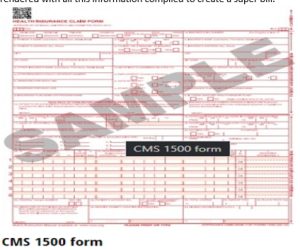
- CHARGE ENTRY: Before it goes for claiming process, the Provider charged medical treatment provided by a doctor according to ICD-10(International Classification of Diseases) which is a standardized classification system of diagnosis codes and do get inserted into the sheet with the proper amount. Once a medical claim is generated it must be checked by the biller to avoid Errors. Claim form which is called as CMS (Centre of Medicaid and Medicare Services)
1500 is prepared to submit to the insurance company.
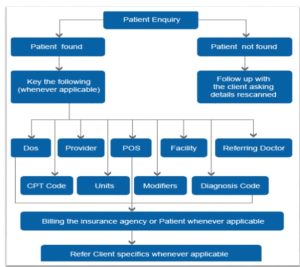
- CLAIMS AUDIT: Through Electronic Data Transfer or postcard/fax claims are sent to the insurer for proof checking the patient’s record and does it fulfills the policy criteria and account is still active or not. If any errors are seen it can be sent with Rejection Message.
- CLAIMS TRANSMISSION: Claims generated from Computer Software which are then transmitted to the insurance company only when claims are error-free.
- DENIAL MANAGEMENT: Rejection of the claim due to Incorrect Information provided or claiming not done in time bound manner or the patient’s insurance account is not active then it is sent again for rectify the problem. And only after Correction further, proceedings are continued.
- PATIENT STATEMENT PREPARATION: After Claiming procedure is done, the Patient gets a detailed list of the payment paid by the insurer or if any amount is in due, therefore the patient statement is prepared.
- AR CALLING: AR (Accounts Receivable Callers) are Professionals who get in touch with insurance companies when a claim seems faulty or during unpaid problem conditions.
- PAYMENT POSTING: Payments are delivered to the hospital electronically and the Date of service rendered will be closed and further take-up action would be continued by the holder.
ADVANTAGE
- Automating workflows can reduce the processing time by 48%.
- 91% of Consumers prefer Electronic Payment methods for Medical Bills.
- Earlier Healthcare Information was based solely on Paperwork and was Tedious, Time-Consuming but with this Technology, work goes swiftly.
- As its Advantage shows its demand and its service expectation is booming.
- It provides a Suitable Platform to record millions of patient medical history in just minutes, Human Errors are Negligible and quickly verify the Insurance Eligibility status.
- Reimbursement is done on time and Rejection from the Insurance Company is also Minimal.
DISADVANTAGE
Every process has a bad face and we have to eradicate so to enjoy its happy face.
- Delay in On-Time Payments
- Denials to Providers
- Medical billing Resources still lacking
- Revenue Loss is one such Problem and to get rid of it healthcare systems are now focusing on software-based billing processes.
- 77% of Providers it takes more than a Month to collect Payment with paper-based billing.
HOW LONG IT TAKES: It would take a Month to complete a billing cycle and how efficiently the process should work is how proactive measures are taken to fasten or streamlined it. Software such as Lytec, Medisoft, Ingenix used in this billing procedure.
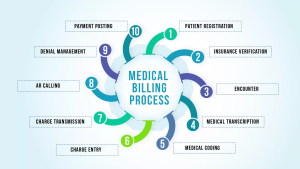
Growth of this Sector:
The medical coding and billing industry is expected to grow rapidly in the near future, as more hospitals and private practices replace their manual billing processes with software and technology. Remote Care (and Remote Billing) Functions can speed up the Health care sector.
75% of Providers primarily used Paper and Manual processes for Collection.
- 50% of providers are improving telehealth options in continuing response to the pandemic.
- 51% of providers prioritize their digital payment experience.
- 70% of consumers receive medical bills through the mail, but only 9% want to pay those bills with paper checks.
Take an Example of Monkey Pox, COVID-19 Pandemic where more than 1 lakhs-millions cases registered with which patient are admitted to hospital to get treated but Imagine Medical biller has to manage all it by themselves, it’s now peak time in adopting outsourced medical billing System and Artificial Intelligence and so that Hospital do get attached to such company like PETTIGREW who provide medical business services where they get uniform platform in dealing with Clinical Documentation with ease. Medical Billing software currently used RXNT, eCLINICALWORK, CareCloudCentre, WebPt, gGAGTRO, CarePath EHR etc, this helps in Automated Billing Task. These SOFTWARE deals with all processes given below in flow chart in time bound manner efficiency and accuracy, it also includes optional cloud computing features. Sophisticated security protocols ensure that patient data will remain confidential and safe. Right hand-side Flow Chart reminds you the advantages of using Medical Billing Software. Popular Indian Medical Billing Services – Info Hub Services, Knack Global, Omega Healthcare, Access Healthcare. According to the Bureau of Labor and Statistics, the medical billing field is expected to grow by 15%.
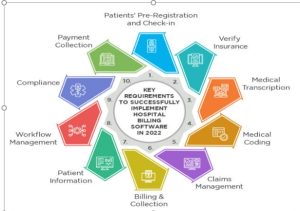
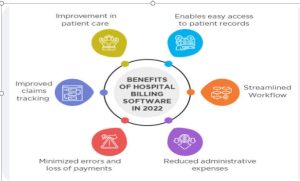
CONCLUSION:
Due to Covid-19, there was Havoc in billing systems as seen on average medical facility depletes 11% of their net revenue due to underpayments, so to overcome we have come up with Medical Coding Solutions that includes Broad Spectrum Functionalities as per Hospital Requirement to cope with understaffed problems, Minimizing inaccuracies with involvement of Data Analytics, Integrating Medical Encoding Software or Advanced Methodologies with HIPAA, Medicare, and Medicaid regulations results in accurate claims with free Human errors and proficiency in managing database also timely Acknowledging them with New Terms and Conditions. Efficiently managing time and also Establishes Long-lasting Relations with Payers. Accounting Cash growth and Revenue cycle growth. Post-pandemic Telehealth adoption is one of the most significant evolution in healthcare which accelerates health capacity. Emerging self-pay patient billing methods to foster better payments and also adding new reimbursement policies and regulations.
References:
- www.medsitnexus.com
- www.invensis.net
- www.businessintegrityservices.com
- www.outsourcestrategies.com
- www.pettigrewmedical.com
- https://mticollege.edu/
- www.softwareadvice.com
- https://www.collaboratemd.com/
- https://www.solvedge.com/
 Book a Demo to Build Your Team Today!
Book a Demo to Build Your Team Today!
 Read Case Studies
Read Case Studies 


 Virtual Medical Assistants
Virtual Medical Assistants



